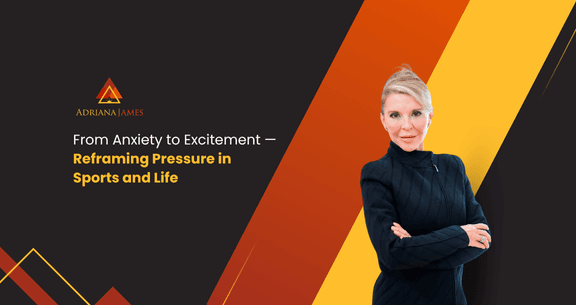Pressure Isn’t the Problem
Everyone wants to perform well when it counts.
But pressure has a funny way of sneaking in when the stakes rise. Whether it’s a championship match, a job interview, or even a crucial conversation, your brain and body respond the same way:
- Racing heart
- Shallow breath
- Tight chest
- Overthinking
Sound familiar?
Most people call this anxiety.
But here’s the truth no one tells you:
Anxiety and excitement feel the same in the body.
Same chemicals. Same activation. The only real difference? How you label it.
This article will show you how to reframe pressure using performance psychology and NLP, so you can turn nerves into fuel and perform at your best when it matters most.
Step 1: Understand the Biology of Activation
When you’re under pressure, your body activates the sympathetic nervous system. It’s your built-in high-alert system designed to help you respond quickly and effectively.
This means:
- Adrenaline gets released
- Your heart rate increases
- Focus narrows
- Muscles tense
Whether you’re about to fight off a threat, run from danger, or serve a match point, your body goes through the same sequence.
That physical response is not the enemy. In fact, it means your system is ready.
What causes problems is when your mind interprets that response as a threat.
That’s where the spiral begins:
“Why am I nervous?”
“What if I screw this up?”
“I can’t calm down.”
And now you’re fighting your own biology.
Step 2: Shift the Label
Here’s the mental pivot elite performers make:
Instead of saying, “I’m nervous,” they say:
- “I’m activated.”
- “I’m ready.”
- “This is energy I can use.”
This shift may sound simple, but it’s powerful. Your brain follows the language you give it.
Try this:
Next time you feel pressure building, take a breath and say to yourself:
“This is what readiness feels like.”
Because it is.
Pressure is not the enemy. Misinterpreting pressure is.
Step 3: Anchor Into the Present Moment
Pressure thrives in the future:
- What if I fail?
- What will people think?
- What if I let the team down?
The antidote to future-based fear is present-based focus.
Ask yourself:
- What are 1 to 3 things I can control right now?
- Where do I want to put my attention?
- What physical cue can I use to reset?
Some athletes use breath. Others use a trigger word, a posture shift, or a short internal phrase like “right here, right now.”
Anchoring to the moment pulls your nervous system back into execution mode.
This isn’t just a nice idea. It’s tactical performance control.
Step 4: Use Pre-Performance Rehearsal
You can practice reframing before the pressure hits.
Inside The Leadership Edge, I walk athletes through pre-performance priming, which includes:
- Intentional visualization (with emotional connection)
- Identifying pressure triggers ahead of time
- Installing helpful self-talk before the moment
Here’s a simple version:
- Visualize an upcoming high-pressure moment.
- Imagine your body responding with adrenaline.
- Tell yourself: “This is excitement. My body is preparing me to win.”
- See yourself executing with calm precision.
Rehearse that loop until your body and mind link pressure with readiness.
Because when that moment comes in real life, your nervous system will already know what to do.
Step 5: Reflect and Reinforce
After the moment has passed, don’t just move on. Take two minutes to reflect:
- How did I reframe pressure?
- What helped me stay present?
- What would I do again next time?
Every pressure moment is a training rep.
When you take time to reinforce the behaviors that worked, you lock in those wins.
This is how athletes build composure. Not through motivation. Through mental reps and reflection.
Final Thoughts: Pressure Is a Privilege
Let’s zoom out for a second.
The pressure you feel? It means you’re doing something that matters. You care. You’ve put in the work. You’re on the edge of growth.
Reframing anxiety as excitement doesn’t mean faking positivity. It means recognizing the energy is already there — and learning how to use it.
This is what mental mastery looks like:
- You stop fearing pressure.
- You stop waiting to feel calm.
- You learn how to stabilize yourself and lead your mind.
Want to build these tools into your routine?
Download The Leadership Edge: Activate Your Influence, Accelerate Your Growth.
It’s a free guide packed with high-performance psychology tools to help you lead under pressure without losing your edge.
Be well,
Dr. Adriana James

